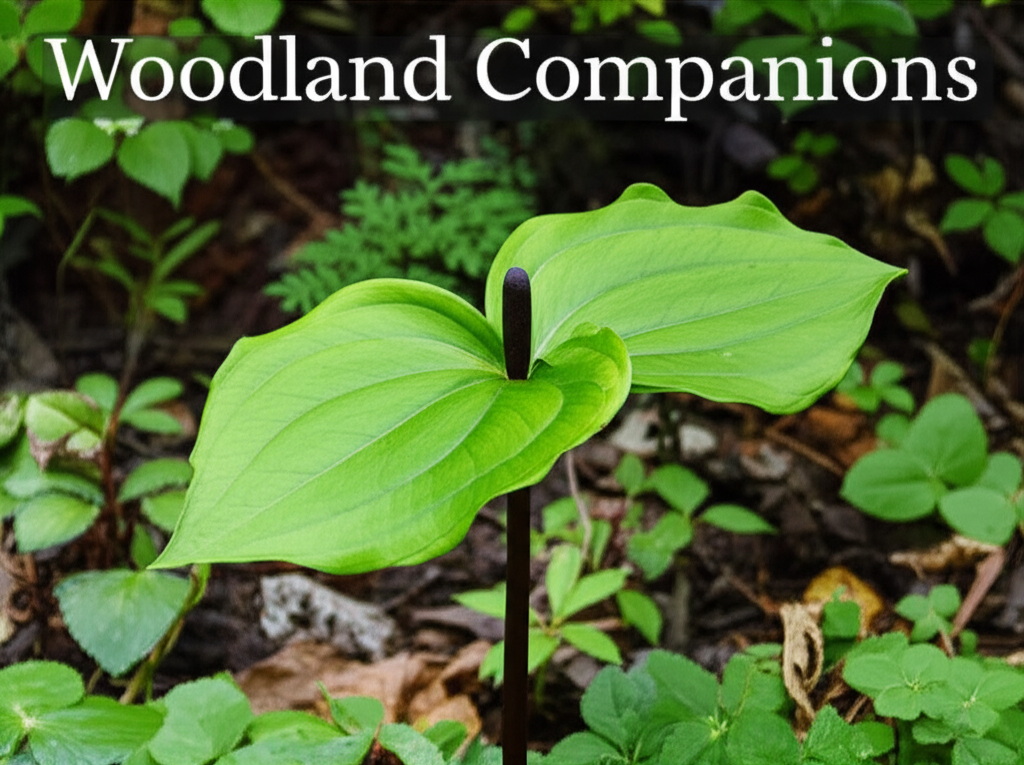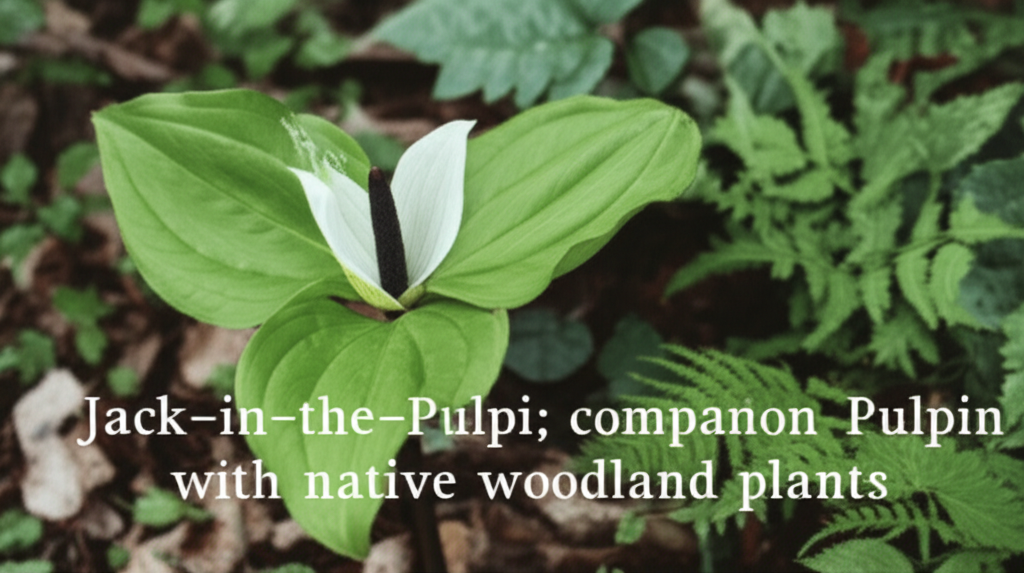The Enigmatic Jack-in-the-Pulpit: A Woodland Jewel
The Jack-in-the-Pulpit (Arisaema triphyllum) is one of the most captivating and unique plants of the North American temperate woodland. Its distinctive “jack” (spathe) enclosing the “pulpit” (spadix) creates a natural marvel that has long intrigued botanists and gardeners alike. This woodland understory specialist thrives in moist, shaded environments, typically found in rich, humusy soils. Beyond its striking appearance, the Jack-in-the-Pulpit plays a vital role in its ecosystem, and understanding its needs can unlock the secrets to successful companion planting within its native habitat.
Companion planting, the practice of growing different plants together for mutual benefit, is a cornerstone of ecological gardening. When we consider companion planting for the Jack-in-the-Pulpit, we’re not just aiming for aesthetic appeal; we’re aiming to replicate the plant’s natural community, fostering biodiversity, improving soil health, and deterring pests. This approach honors the intricate relationships that exist within a healthy woodland ecosystem.
Why Companion Planting for Jack-in-the-Pulpit?

The decision to companion plant with Jack-in-the-Pulpit stems from several ecological and horticultural benefits:
- Mimicking Natural Habitats: In the wild, Jack-in-the-Pulpit is rarely found in isolation. It coexists with a diverse array of native woodland flora, each contributing to the overall health of the environment. Companion planting allows us to recreate these natural associations in our gardens.
- Improved Soil Health: Different plants have varying nutrient requirements and root structures. Planting a diverse community can lead to more efficient nutrient cycling, better soil aeration, and increased organic matter.
- Pest and Disease Management: Certain companion plants can act as natural deterrents to pests that might target the Jack-in-the-Pulpit, or vice versa. This reduces the need for chemical interventions.
- Enhanced Biodiversity: A well-chosen selection of companion plants can attract beneficial insects, pollinators, and other wildlife, further enriching the garden ecosystem.
- Aesthetic Appeal: The subtle beauty of the Jack-in-the-Pulpit is amplified when paired with plants that complement its form, texture, and seasonal interest.
Key Companion Plants for Jack-in-the-Pulpit
Selecting the right companions is crucial for the success of your Jack-in-the-Pulpit patch. The ideal partners will share similar growing conditions: dappled shade to full shade, moist, well-drained, organically rich soil, and a preference for the same humidity levels.
Ferns: The Woodland’s Embrace
Ferns are quintessential woodland companions, offering a lush, textural backdrop and fulfilling many of the needs of the Jack-in-the-Pulpit.
1. Ostrich Fern (Matteuccia struthiopteris)
Known for its tall, vase-shaped fronds, the Ostrich Fern provides ample shade and moisture retention. Its vigorous rhizomatous growth can help fill in spaces and create a dense ground cover.
2. Lady Fern (Athyrium filix-femina)
With its delicate, lacy fronds, the Lady Fern offers a softer texture that beautifully contrasts with the bolder form of the Jack-in-the-Pulpit. It also thrives in moist, shaded conditions.
3. Christmas Fern (Polystichum acrostichoides)
A classic evergreen, the Christmas Fern provides year-round interest and structure. Its leathery fronds can tolerate slightly drier conditions once established, making it a versatile companion.
Wildflowers: Adding Color and Life
Incorporating native wildflowers can introduce seasonal color, attract pollinators, and further enhance the woodland aesthetic.
1. Wild Ginger (Asarum canadense)
This low-growing groundcover features attractive, heart-shaped leaves and a subtle, spicy fragrance. It forms a dense carpet, suppressing weeds and retaining soil moisture.
2. Foamflower (Tiarella cordifolia)
Recognized for its frothy, white flower spikes in spring, Foamflower adds a delicate touch. Its attractive foliage also provides interest throughout the season.
3. Columbine (Aquilegia canadensis)
The nodding, red and yellow blossoms of the native Columbine are a magnet for hummingbirds and other pollinators. It prefers a slightly more open shade than the Jack-in-the-Pulpit but can coexist successfully.
4. Bleeding Heart (Dicentra spectabilis or Dicentra eximia)
The iconic heart-shaped flowers of Bleeding Heart add a romantic element. The native Dicentra eximia is particularly well-suited to woodland settings and offers a longer bloom period.
Groundcovers: For Soil Health and Weed Suppression
Low-growing groundcovers are essential for maintaining soil moisture, preventing erosion, and outcompeting weeds.
1. Mayapple (Podophyllum peltatum)
Mayapple forms colonies with its umbrella-like leaves and produces a single white flower followed by an edible fruit. It offers a unique architectural element to the woodland garden.
2. Partridgeberry (Mitchella repens)
This evergreen groundcover has small, rounded leaves and produces tiny white flowers followed by bright red berries that persist into winter. It thrives in cool, moist, acidic soils.
Shrubs: Providing Structure and Shade
Larger companions can provide crucial shade and structure, creating the microclimate that Jack-in-the-Pulpit prefers.
1. Canada Violet (Viola canadensis)
While often treated as a perennial, violets can spread to form a low-growing groundcover. Their small white and purple flowers are charming and attract early pollinators.
2. Blue-stemmed Goldenrod (Solidago caesia)
This graceful goldenrod features arching stems and delicate yellow flowers, typically blooming in late summer or fall. It prefers a woodland setting and can tolerate shade.
Key Facts and Comparison of Companion Plants
Understanding the specific needs and characteristics of potential companion plants is vital for creating a harmonious planting. The following table outlines key facts about some of the recommended species:
| Plant Name | Bloom Time | Light Preference | Soil Moisture | Height | Native Region |
|---|---|---|---|---|---|
| Jack-in-the-Pulpit (Arisaema triphyllum) | Spring | Dappled to Full Shade | Moist | 1-2 ft | Eastern North America |
| Ostrich Fern (Matteuccia struthiopteris) | Non-flowering | Partial to Full Shade | Moist to Wet | 2-6 ft | North America, Asia |
| Lady Fern (Athyrium filix-femina) | Non-flowering | Partial to Full Shade | Moist | 1-3 ft | Cosmopolitan |
| Christmas Fern (Polystichum acrostichoides) | Non-flowering | Shade | Average to Moist | 1-2 ft | Eastern North America |
| Wild Ginger (Asarum canadense) | Spring | Shade | Moist | 0.5-1 ft | Eastern North America |
| Foamflower (Tiarella cordifolia) | Spring | Partial to Full Shade | Moist | 0.5-1.5 ft | Eastern North America |
| Columbine (Aquilegia canadensis) | Spring | Partial Shade to Light Shade | Average to Moist | 1-3 ft | Eastern North America |
| Bleeding Heart (Dicentra eximia) | Spring to Summer | Partial to Full Shade | Moist | 1-1.5 ft | Eastern North America |
| Mayapple (Podophyllum peltatum) | Spring | Partial to Full Shade | Moist | 1-1.5 ft | Eastern North America |
| Partridgeberry (Mitchella repens) | Spring to Summer | Shade | Moist, Acidic | 0.25-0.5 ft | Eastern North America |
| Canada Violet (Viola canadensis) | Spring to Summer | Partial to Full Shade | Moist | 0.5-1 ft | Eastern North America |
| Blue-stemmed Goldenrod (Solidago caesia) | Late Summer to Fall | Partial Shade to Shade | Average to Moist | 1-3 ft | Eastern North America |
Creating the Ideal Woodland Garden: Steps and Considerations
Establishing a successful companion planting scheme for Jack-in-the-Pulpit requires careful planning and execution. The goal is to create a thriving, self-sustaining micro-environment.
Steps for Planting
- Site Selection: Choose a location that receives dappled shade or morning sun and afternoon shade. The soil should be rich in organic matter and consistently moist but well-drained. Avoid areas that are waterlogged or excessively dry.
- Soil Preparation: Amend the soil with compost, leaf mold, or other organic materials to improve fertility and structure. Ensure good drainage by incorporating perlite or coarse sand if your soil is heavy.
- Plant Spacing: Consider the mature size of each plant. Give the Jack-in-the-Pulpit adequate space, typically 12-18 inches apart, and allow its companions to grow around it. Group plants with similar needs together.
- Planting Techniques: Plant the Jack-in-the-Pulpit corms at a depth of about 4-6 inches, with the pointed end facing upwards. For other plants, follow their specific planting depth recommendations.
- Mulching: Apply a layer of organic mulch, such as shredded bark or leaf litter, around the plants. This helps retain moisture, suppress weeds, and regulate soil temperature.
- Watering: Water newly planted specimens thoroughly. Maintain consistent moisture, especially during dry periods, but avoid overwatering.
- Ongoing Care: Once established, the woodland garden will require minimal intervention. Remove any invasive weeds and provide supplemental watering during extended droughts.
Pros and Cons of Companion Planting with Jack-in-the-Pulpit
While the benefits of companion planting are numerous, it’s also important to be aware of potential challenges.
| Pros | Cons |
|---|---|
| Enhanced Ecosystem Health: Fosters biodiversity and supports a healthy soil food web. | Competition for Resources: Overly vigorous companions can sometimes outcompete slower-growing plants. |
| Natural Pest Deterrence: Certain plants can repel pests that might affect the Jack-in-the-Pulpit. | Requires Careful Selection: Choosing plants with incompatible needs can lead to poor growth. |
| Improved Soil Structure and Fertility: Diverse root systems contribute to better soil. | Initial Planning and Effort: Requires research and careful consideration of plant needs. |
| Aesthetic Beauty: Creates a layered, visually appealing woodland scene. | Potential for Overcrowding: If not managed, some spreading plants can become invasive. |
| Reduced Maintenance: A well-established ecosystem can become more self-sufficient. | Slower Establishment: Woodland gardens often take a few seasons to fully mature. |
Seasonal Interest and Ecosystem Support
A well-planned Jack-in-the-Pulpit garden offers a dynamic display of seasonal interest, mirroring the natural rhythms of the woodland.
Spring Awakening
As the soil warms, the distinctive Jack-in-the-Pulpit emerges, often alongside the delicate blooms of Foamflower and Columbine. Ferns begin to unfurl their fiddleheads, adding a fresh green hue.
Summer Lushness
The Jack-in-the-Pulpit matures, its spathe often turning green or striped. Mayapple forms its characteristic umbrellas, and Bleeding Heart provides continuous floral beauty. The lush foliage of ferns creates a cool, shaded understory.
Autumn Grandeur
The spathe of the Jack-in-the-Pulpit may develop striking red berries. Goldenrod offers late-season color, and the foliage of some ferns may begin to show autumnal tones. Partridgeberry’s red berries add a festive touch.
Winter Structure
Even in winter, the garden holds interest. The evergreen fronds of Christmas Fern provide color, and the persistent berries of Partridgeberry offer sustenance for birds. The skeletal structure of the dormant Jack-in-the-Pulpit remains, hinting at the life to come.
Conclusion: A Thriving Woodland Haven
Cultivating Jack-in-the-Pulpit through companion planting is a rewarding endeavor that not only beautifies the garden but also contributes to a healthier, more resilient ecosystem. By carefully selecting native woodland plants that share its preference for shade and moisture, we can create a harmonious environment where the enigmatic Jack-in-the-Pulpit can truly flourish. This approach honors the interconnectedness of nature, offering a living testament to the beauty and resilience of our native flora. Embrace the principles of ecological gardening, and witness the magic of a thriving woodland community unfold in your own backyard.
